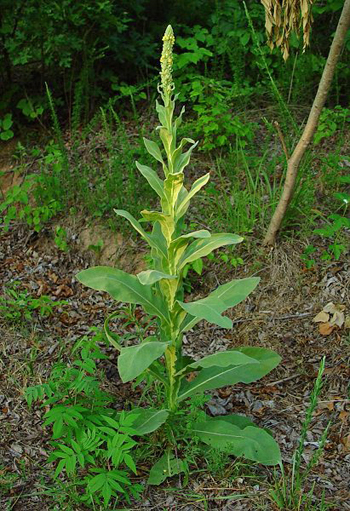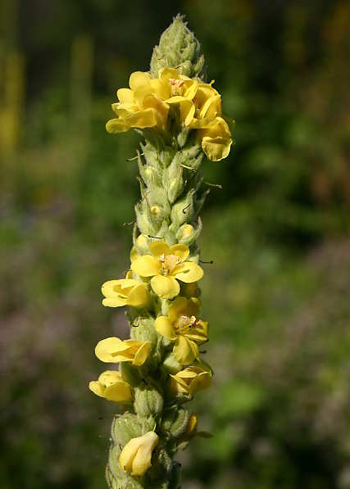Contents:
Common Names | Parts Usually Used | Plant(s) & Culture | Where Found | Medicinal Properties | Biochemical Information
Legends, Myths and Stories | Uses | Formulas or Dosages | Nutrient Content | How Sold | Warning | Resource Links | Bibliography
Scientific Names

- Verbascum thapsus L.
- Scrophulariaceae
- Figwort family
Common Names
- Aaron’s rod
- Blanket leaf
- Bullock’s lungwort
- Candlewick
- Cow’s lungwort
- Flannel dock
- Flannel flower
- Feltwort
- Great mullein
- Hare’s beard
- Hedge-taper
- Jacob’s staff
- Mullein dock
- Old man’s flannel
- Pig taper
- Shepherd’s club
- Velvet dock
- Velvet leaf
- Velvet plant
- Verbascum flowers
- White mullein
- Woollen blanket herb
Parts Usually Used
Leaves, flowers, root
Back to Top
Description of Plant(s) and Culture

Mullein is a tall biennial plant; the tall, stout, simple or branched stem bears alternate, thick, felt-like, light green leaves, whose stems are winged by decurrent bases and are woolly with many star-shaped hairs and their bases run down the stem. There is also a basal rosette of larger, obovate-lanceolate or -oblong leaves. Yellow, sessile flowers grow in cylindrical spikes, 1 to 3 inches long, from June to September. The flower stalk does not develop until the second year. Fruits are woolly capsules.
Other varieties: Common mullein (V. thapsiforme); Orange mullein (V. phlomoides); Black mullein (V. nigrum).
Back to Top
Where Found
Grows in clearings, fields, roadsides, sand pits, gravel pits, pastures, and waste places (seems to thrive in the poorest of soils) from the Atlantic coast west to South Dakota and Kansas. Naturalized from Europe.
Back to Top
Medicinal Properties
Diuretic, expectorant, analgesic, tonic, anodyne, antispasmodic, demulcent, vulnerary, astringent, emollient, pectoral, sedative
Back to Top
Biochemical Information
Iron, potassium, sulfur, aucubin, choline, hesperidin, mucilage, traces of essential oil, magnesium, PABA, saponins, verbaside, vitamins B2, B5, B12, and D.
Back to Top
Legends, Myths and Stories
According to Agrippa, a general and minister under Caesar Augustus, mullein leaves, because of their fragrance, had an overpowering effect on demons. More mundanely, the plant was also used by the Greeks and the Romans to make torches or lampwicks by dipping its dried flower-stalks in tallow.
The large stalks were oiled and used for funeral torches in olden times.
In the Middle Ages, people deprecatingly called the mullein “hag taper”, because witches used it in their incantations and as an important ingredient in their brews and love potions.
At the time of Charlemagne mullein was misused for catching fish in “forbidden” waters. Boiling down a large quantity of mullein plants in water and pouring the decoction into fish ponds, the saponins in the mullein will reduce the surface tension of the water to such an extent that the water will get into the gills of the fish, which then drown in their own “element”.
Dioscorides used the herb for scorpion stings, eye complaints, toothache, tonsillitis, and coughs.
The Native Americans used mullein alone or in tobacco mixtures; also used in medicinal smokes.
Back to Top
Uses
For difficult breathing, asthma, glandular swelling, and hay fever. Mullein is used as a pain killer, sleep aid, colic, in the right dosage, can control diarrhea or dysentery, or be a laxative. Gets rid of warts.
Tea makes good remedy for cough, hoarseness, bronchitis, sinusitis, tuberculosis, bronchial catarrh, mumps, and whooping cough. Used for gastrointestinal problems and piles. For external use on inflammations, arthritis, frostbite, gout, or painful skin conditions, use the tea or a fomentation of the leaves boiled or steeped in hot vinegar and water. For nasal congestion, flu, inflammation of nerve tissue, nerve pain, croup, or other respiratory problems, breathe the vapor from hot water with a handful of flowers added. A poultice of leaves or the powder of dried leaves can be used for difficult wounds, boils, ulcers, and sores. Flowers soaked in olive or mineral oil used as earache drops. Excellent pain killer without being habit forming.
Leaves can be boiled in water and the steam can be inhaled to relieve coughs and congestion.
The leaves are smoked, alone or with coltsfoot and yerba santa, to soothe the throat and as a substitute for tobacco.
The seed is a narcotic fish poison.
Back to Top
Formulas or Dosages
Use dried flowers or leaves.
Infusion: steep 1 tsp. leaves or flowers in 1 cup water. Take 1 to 2 cups a day.
Extract: mix 25 to 40 drops in liquid. Drink 3 to 4 times daily for coughs.
Tincture: take 15-40 drops in warm water, every 2 to 4 hours.
Back to Top
Nutrient Content
Iron, potassium, magnesium, vitamins B2, B5, B12, and D.
Back to Top
How Sold
Capsules
Back to Top
Warning
The leaves contain rotenone and coumarin, neither viewed with great favor by the FDA. Hairs may irritate skin.
Do not use as ear drops if there is a risk that the ear drum is perforated.
Back to Top
Resource Links
Bibliography
![]() Back to Eden
Back to Eden, by Jethro Kloss; Back to Eden Publishing Co., Loma Linda, CA 92354, Original copyright 1939, revised edition 1994
![]() Culpeper’s Complete Herbal & English Physician: Updated With 117 Modern Herbs
Culpeper’s Complete Herbal & English Physician: Updated With 117 Modern Herbs, by Nicholas Culpeper, Meyerbooks, publisher, PO Box 427, Glenwood, Illinois 60425, 1990, (reprint of 1814)
 Old Ways Rediscovered
Old Ways Rediscovered, by Clarence Meyer, Meyerbooks, publisher, PO Box 427, Glenwood, Illinois 60425, published from 1954, print 1988
 Earl Mindell’s Herb Bible
Earl Mindell’s Herb Bible, by Earl Mindell, R.Ph., Ph.D., Simon & Schuster/Fireside, Rockefeller Center 1230 Avenue of the Americas, New York, New York 10020
![]() The Herb Book
The Herb Book, by John Lust, Bantam Books, 666 Fifth Avenue, New York, NY. copyright 1974.
![]() Eastern/Central Medicinal Plants
Eastern/Central Medicinal Plants, by Steven Foster and James A. Duke., Houghton Mifflin Company, 215 Park Avenue South, New York, NY 10000
 The Magic of Herbs
The Magic of Herbs, by David Conway, published by Jonathan Cape, Thirty Bedford Square, London, England. (Out of print)
![]() The Herbalist Almanac
The Herbalist Almanac, by Clarence Meyer, Meyerbooks, publisher, PO Box 427, Glenwood, Illinois 60425, copyright 1988, fifth printing, 1994
Herbal Gardening, compiled by The Robison York State Herb Garden, Cornell Plantations, Matthaei Botanical Gardens of the University of Michigan, University of California Botanical Garden, Berkeley., Pantheon Books, Knopf Publishing Group, New York, 1994, first edition
![]() Planetary Herbology
Planetary Herbology, by Michael Tierra, C.A., N.D., O.M.D., Lotus Press, PO Box 325, Twin Lakes. WI 53181., Copyright 1988, published 1992
![]() The Complete Medicinal Herbal
The Complete Medicinal Herbal, by Penelope Ody, Dorling Kindersley, Inc, 232 Madison Avenue, New York, NY 10016, First American Edition, copyright 1993
![]() Indian Herbalogy of North America
Indian Herbalogy of North America, by Alma R. Hutchens, Shambala Publications, Inc., Horticultural Hall, 300 Massachusetts Avenue, Boston, Massachusetts 02115, 1973
![]() American Folk Medicine
American Folk Medicine, by Clarence Meyer, Meyerbooks, publisher, PO Box 427, Glenwood, Illinois 60425, 1973
![]() Prescription for Nutritional Healing, Fifth Edition: A Practical A-to-Z Reference to Drug-Free Remedies Using Vitamins, Minerals, Herbs & Food Supplements
Prescription for Nutritional Healing, Fifth Edition: A Practical A-to-Z Reference to Drug-Free Remedies Using Vitamins, Minerals, Herbs & Food Supplements, by James F. Balch, M.D. and Phyllis A. Balch, C.N.C., Avery Publishing Group, Inc., Garden City Park, NY
 An Instant Guide to Medicinal Plants
An Instant Guide to Medicinal Plants, by Pamela Forey and Ruth Lindsay, Crescent Books (January 27, 1992).
![]() Webster’s New World Dictionary
Webster’s New World Dictionary, Third College Edition, Victoria Neufeldt, Editor in Chief, New World Dictionaries: A Division of Simon & Schuster, Inc., 15 Columbus Circle, New York, NY 10023
 A Useful Guide to Herbal Health Care
A Useful Guide to Herbal Health Care, HCBL (Health Center for Better Living).,1414 Rosemary Lane, Naples, FL 34103., Special Sale Catalog, 1996
![]() The Yoga of Herbs: An Ayurvedic Guide to Herbal Medicine
The Yoga of Herbs: An Ayurvedic Guide to Herbal Medicine, by Dr. David Frawley & Dr. Vasant Lad, Lotus Press, Twin Lakes, Wisconsin, Second edition, 1988.
 The Healing Plants
The Healing Plants, by Mannfried Pahlow, Barron’s Educational Series, Inc. 250 Wireless Blvd., Hauppauge, NY 11788, 1992
 The Rodale Herb Book: How to Use, Grow, and Buy Nature’s Miracle Plants (An Organic gardening and farming book)
The Rodale Herb Book: How to Use, Grow, and Buy Nature’s Miracle Plants (An Organic gardening and farming book), edited by William H. Hylton, Rodale Press, Inc. Emmaus, PA, 18049., 1974
